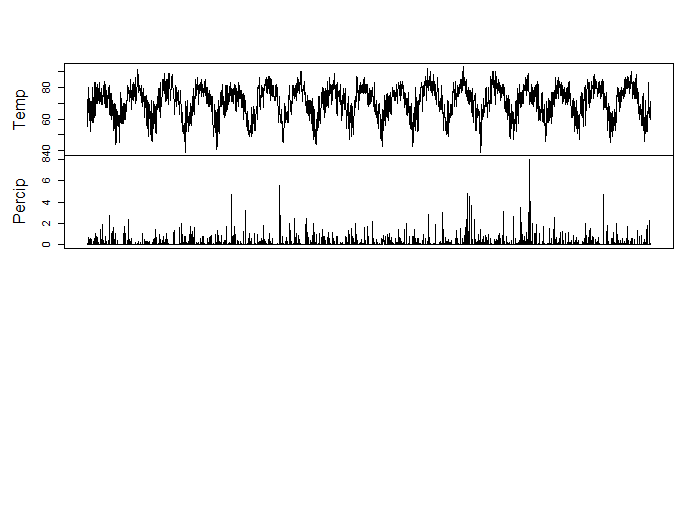Time series analysis is very useful in economics but I have been using it in my studies of mosquitoes and climate change in environmental health. The relationship that I am examining is whether or not the climate change had any effect on increased mosquito quantity within trapping areas over 17+ years. The first step of that process is to see if there was a change in climate over the 17+ years that match the mosquito collection data.
The mosquito season starts in May and ends in October, and it is common for field workers to set traps every Monday through Thursday, leave them for 24 hours and then collect the traps to have the mosquitoes tested. So, all precipitation and temperature data was collected from The National Oceanic and Atmospheric Administration Department of Commerce.
Working within R and using the Stats package, I was able to transform the dataframe into a time series class and visualize over time.
library(stats)print(climate)
class(climate)
length(climate)
Results :
print(climate)
Temp Percip Date time
1 55 0.00 5/1/2000 2000-05-01
2 59 0.09 5/2/2000 2000-05-02
3 60 0.00 5/3/2000 2000-05-03
...
class(climate)
[1] "tbl_df" "tbl" "data.frame"
length(climate)
[1] 4
Now, we transform the dataframe to a ts object
climatets <- ts(climate, start = 1, frequency = 1)
print(climatets)
length(climatets)
Results :
> climatets <- ts(climate, start = 1, frequency = 1) Warning message: In data.matrix(data) : NAs introduced by coercion
print(climatets)
Time Series:
Start = 1
End = 3159
Frequency = 1
Temp Percip Date
1 55 0.00 NA
2 59 0.09 NA
3 60 0.00 NA
...
length(climatets)
[1] 12636
plot(climatets)

It is common for string dates to be eliminated in the time series transformation. If you would like to keep them for labeling purposes, I would investigate ?as.POSIXlt() for date time numeric conversion.
You can see that there is a slight upward trend in temperature over the 17+ years. But for the most part, the climate over the 17 years doesn’t change much in trend. Which tells me that if there has been an increase in mosquito quantity at trapping sites, it may not be connected to temperature.
This way of visualizing data is essential in making predictive modeling and recognizing trends.
